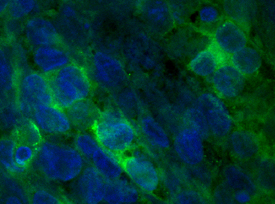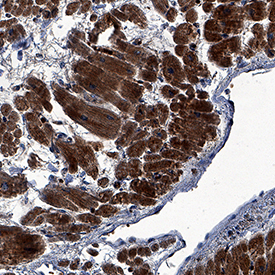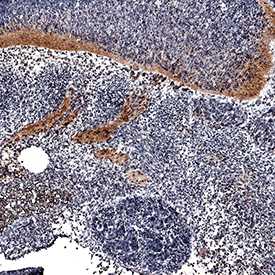Human/Mouse FGF-16 Antibody Summary
Ala2-Arg207
Accession # O43320
Applications
Please Note: Optimal dilutions should be determined by each laboratory for each application. General Protocols are available in the Technical Information section on our website.
Scientific Data
 View Larger
View Larger
FGF‑16 in Human iPS cells. FGF-16 was detected in immersion fixed human induced pluripotent stem (iPS) cells differentiated into cardiomyocytes using Sheep Anti-Human/Mouse FGF-16 Antigen Affinity-purified Polyclonal Antibody (Catalog # AF1212) at 8 µg/mL for 3 hours at room temperature. Cells were stained using the NorthernLights™ 493-conjugated Anti-Sheep IgG Secondary Antibody (green; Catalog # NL012) and counterstained with DAPI (blue). Specific staining was localized to cytoplasm. View our protocol for Fluorescent ICC Staining of Stem Cells on Coverslips.
 View Larger
View Larger
FGF‑16 in Human Heart. FGF-16 was detected in immersion fixed paraffin-embedded sections of human heart using Sheep Anti-Human/Mouse FGF-16 Antigen Affinity-purified Polyclonal Antibody (Catalog # AF1212) at 3 µg/mL overnight at 4 °C. Tissue was stained using the Anti-Sheep HRP-DAB Cell & Tissue Staining Kit (brown; Catalog # CTS019) and counterstained with hematoxylin (blue). Specific staining was localized to cardiomyocytes. View our protocol for Chromogenic IHC Staining of Paraffin-embedded Tissue Sections.
 View Larger
View Larger
FGF‑16 in Mouse Embryo. FGF-16 was detected in perfusion fixed frozen sections of mouse embryo (13 d.p.c.) using Sheep Anti-Human/Mouse FGF-16 Antigen Affinity-purified Polyclonal Antibody (Catalog # AF1212) at 15 µg/mL overnight at 4 °C. Tissue was stained using the Anti-Sheep HRP-DAB Cell & Tissue Staining Kit (brown; Catalog # CTS019) and counterstained with hematoxylin (blue). Specific staining was localized to roots of dorsal ganglia and spinal cord. View our protocol for Chromogenic IHC Staining of Frozen Tissue Sections.
 View Larger
View Larger
Cell Proliferation Induced by FGF‑16 and Neutralization by Human FGF‑16 Antibody. Recombinant Human FGF-16 (Catalog # 1212-FG) stimulates proliferation in the NR6R-3T3 mouse fibroblast cell line in a dose-dependent manner (orange line). Proliferation elicited by Recombinant Human FGF-16 (100 ng/mL) is neutralized (green line) by increasing concentrations of Sheep Anti-Human/Mouse FGF-16 Antigen Affinity-purified Polyclonal Antibody (Catalog # AF1212). The ND50 is typically 3-9 µg/mL.
Reconstitution Calculator
Preparation and Storage
- 12 months from date of receipt, -20 to -70 °C as supplied.
- 1 month, 2 to 8 °C under sterile conditions after reconstitution.
- 6 months, -20 to -70 °C under sterile conditions after reconstitution.
Background: FGF-16
Fibroblast growth factor 16 (FGF-16) belongs to the large FGF family which has at least 23 members (1). All FGF family members are heparin-binding growth factors with a core 120 amino acid (aa) FGF domain that allows for a common tertiary structure. FGFs are expressed during embryonic development and in restricted adult tissues. They act on cells of mesodermal and neuroectodermal origin to regulate diverse physiologic functions including angiogenesis, cell growth, pattern formation, embryonic development, metabolic regulation, cell migration, neurotrophic effects and tissue repair (2, 3). Signaling receptors for FGFs are type I transmembrane receptor tyrosine kinases belonging to the immunoglobulin (Ig) superfamily. Four distinct but related classes of FGF receptors, FGF R1, 2, 3, and 4, exist. Through alternative splicing, multiple isoforms for FGF R1, 2 and 3, with distinct ligand recognition profiles, are also generated (3).
FGF-16 was originally identified in rat heart tissue by homology based polymerase chain reaction. Human FGF-16 cDNA predicts a 207 aa precursor protein with one N-linked glycosylation site. FGF-16 lacks a typical signal peptide, but is efficiently generated by mechanisms other than the classical protein secretion pathway. Among FGF family members, FGF-16 is most similar to FGF-9, sharing 73% aa sequence homology. Human FGF-16 shares 99% and 98.6% aa sequence identity with the mouse and rat FGF-16, respectively. In rat embryos, FGF-16 message is expressed predominantly in brown adipocytes. In adult animals, it is localized primarily in heart tissue. FGF-16 binds to and activates FGF receptor 4 (4). FGF-16 induces proliferation of primary adipocytes and oligodendrocytes in vitro and stimulates liver weight increase in vivo (4, 5). The expression pattern of FGF-16 and its effect on adipocyte proliferation suggest a role for this protein on the proliferation of embryonic brown adipose tissue (4).
- Miyake, A. et al. (1998) Biochem. Biophys. Res. Com. 243:148.
- Goldfarb, M. (1996) Cytokine and Growth Factor Reviews 7:311.
- Green, P. et al. (1996) BioEssays 18:639.
- Konishi, M. et al. (2000) J. Biol. Chem. 275:12119.
- Danilenko, D.M. et al. (2000) Archiv. Biochem. Biophys. 361:34.
Product Datasheets
FAQs
No product specific FAQs exist for this product, however you may
View all Antibody FAQsReviews for Human/Mouse FGF-16 Antibody
There are currently no reviews for this product. Be the first to review Human/Mouse FGF-16 Antibody and earn rewards!
Have you used Human/Mouse FGF-16 Antibody?
Submit a review and receive an Amazon gift card.
$25/€18/£15/$25CAN/¥75 Yuan/¥2500 Yen for a review with an image
$10/€7/£6/$10 CAD/¥70 Yuan/¥1110 Yen for a review without an image

